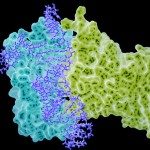Link to Pubmed [PMID] – 14691216
Protein Sci. 2004 Jan;13(1):1-14
It was shown previously that complementation could be a powerful mean to probe protein-protein interactions in the normally tetrameric R67 DHFR. Indeed, mixing complementing inactive dimeric mutants produced active heterotetramers. This approach turned a homo-oligomer into a hetero-oligomer and thus allowed the use of combinatorial assays, a subtle analysis of the association forces, and a precise determination of the equilibrium dissociation constants (K(D)) by titrimetry. However, for some of the complementing pairs, the experimental data implied multiple equilibria involving heterodimers, although no monomers could be detected. Thus, the reactions involved had to be identified to elaborate a suitable model to determine the K(D) of those pairs correctly. That model suggested that homodimers associated rapidly before the protomers could be redistributed in a multiple equilibrium system. Kinetic data confirmed that view. The association data at equilibrium were analyzed by multiple curve fitting with all plausible combinations of parameters. This gave a confidence interval for K(D) that is safer than the usual 67% or 90% confidence interval. Finally, the K(D) of one specific reaction, the dissociation of a heterotetramer with the relevant symmetry into two homodimers could be determined with the relevant model for each complementing pair, although multiple equilibria were present. These K(D) can thus be used as a set of references data to test and improve theoretical methods such as association free energy calculations.

